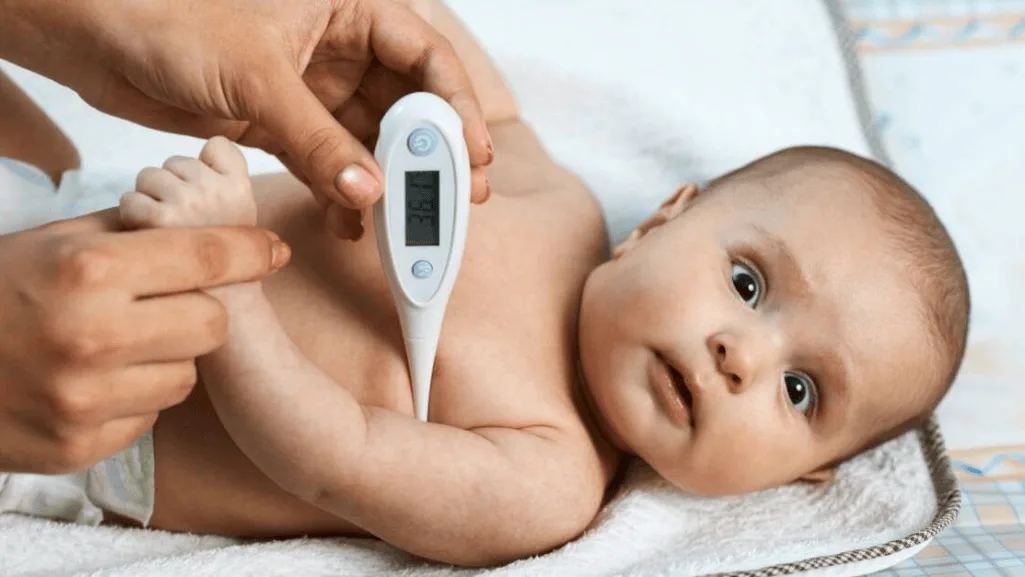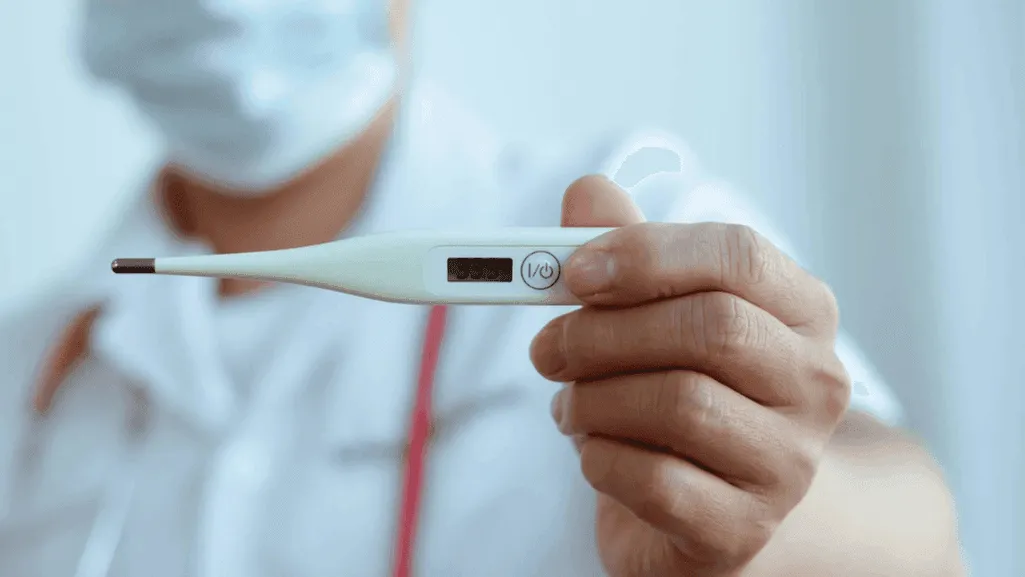Fever sleeplessness can make you feel uncomfortable and restless. It’s hard to fall or stay asleep. A fever is when your body’s temperature goes over 97-99°F (36-37°C). This usually means your body is fighting off an infection or illness.
Symptoms like night sweats, fatigue, body aches, and chills often come with fever. Fevers can be low-grade or high. A low-grade fever is between 99.5 to 100.3°F (37.5-38°C). A high fever is over 102°F (38.9°C).
The fever threshold is different for adults and children. Adults have a fever at 100.4°F (38°C), while children have it at 99.5°F (37.5°C). Anxiety and sleep disorders can also make it hard to sleep when you have a fever.
It’s important to watch for fever symptoms and see a doctor if they last more than three days or get worse. Doctors might suggest over-the-counter medicines like acetaminophen or ibuprofen. They also recommend staying hydrated and resting a lot. Finding out why you have a fever is key to getting better.
Key Takeaways
- Fever is characterized by a rise in body temperature above the normal range of 97-99°F (36-37°C).
- Common symptoms of fever sleeplessness include night sweats, fatigue, body aches, and chills.
- Fever thresholds differ slightly between adults (100.4°F/38°C) and children (99.5°F/37.5°C).
- Treatment may involve over-the-counter medications, staying hydrated, and getting plenty of rest.
- Seeking medical attention is advised if a fever persists for more than three days or worsens.
Understanding Fever and Its Symptoms
Fever, also known as pyrexia or hyperthermia, is a sign the body is fighting off an infection or illness. The average normal body temperature is about 98.6°F (37°C). But, recent studies say it’s now between 97 and 99 degrees Fahrenheit.
Recognizing Fever Symptoms
When your body temperature goes over 100.4°F (38°C) orally, it’s a fever. This is true for adults and kids. For babies, it’s 99°F (37.2°C) armpit and 100.4°F (38°C) rectal.
Common symptoms include:
- Headache
- Chills
- Aching muscles
- Weakness
- Flushed skin
- Difficulty swallowing or feeding (in infants and young children)
Severe fever can cause confusion, convulsions, and severe pain. It can also lead to a skin rash, vomiting, or diarrhea. In kids aged 6 months to 5 years, about 4% may have a seizure with fever. Symptoms include rolling eyes, fainting, stiffening, shaking, and twitching.
Measuring Body Temperature
There are many ways to measure body temperature. You can use oral, ear, armpit, forehead, or rectal thermometers. Oral digital thermometers are best for adults and older kids. Rectal thermometers are better for babies and small children.
It’s important to follow the thermometer’s instructions for use and cleaning. This keeps the readings accurate and safe.
Fever may help in fighting infections by raising the body temperature. This makes it harder for viruses or bacteria to survive. It also helps the immune system make more white blood cells.
While fever is a natural response to infection or illness, it’s important to watch for symptoms. Seek medical help when needed. Knowing the normal body temperature range and recognizing fever signs helps you manage your health and that of your loved ones.
Causes of Fever Sleeplessness
Fever and sleeplessness often go together. The body’s fight against illness can mess with sleep. The CDC says 50 million to 70 million American adults have sleep problems. These issues can lead to mental and physical health problems, including weakened immunity.
Viral and Bacterial Infections
Viral infections like the common cold, flu, and COVID-19 are common causes of fever and sleep issues. Lack of sleep can weaken the immune system, making it harder to fight off illnesses. Sleep-deprived people also get less protection from flu vaccines. Bacterial infections, like ear and urinary tract infections, can also disrupt sleep.
Inflammatory Conditions
Inflammatory conditions, like rheumatoid arthritis and lupus, can cause fever and sleep problems. These conditions trigger the immune system, leading to inflammation and fever. The pain and discomfort make it hard to sleep well. Sleep deprivation can make these symptoms worse, creating a cycle of poor sleep and worsening health.
Medications and Immunizations
Some medications and vaccines can cause fever and sleep issues. Vaccines, like those for flu or COVID-19, may cause a low-grade fever as the body builds immunity. Some medications, used to treat chronic conditions or manage pain, can disrupt sleep. It’s important to talk to a healthcare provider about any side effects to manage fever sleeplessness.
Fever Sleeplessness in Different Age Groups
Fever and sleep issues can happen to anyone, but the worries change with age. Knowing when to get help is key for babies, kids, and adults.
Fever in Babies and When to Worry
Babies under 3 months need quick medical help if their temperature hits 100.4°F (38°C) or higher. Newborns and young babies often face bacterial infections that can get worse fast.
About 4% of kids have a sleep disorder. Look out for signs like green vomit, dehydration, and a bulging soft spot. These could mean serious issues like meningitis or infections.
Fever in Children and When to Seek Medical Attention
For kids 3-6 months, see a doctor if the fever lasts more than a day or comes with other symptoms. Kids with certain health issues are at higher risk of serious infections.
As The Merck Manual notes, fevers over 105°F (40.6°C) mean an infection. Serious cases often have temperatures above 105°F (40.6°C).
Fever in Adults and When to Consult a Doctor
In adults, a fever over 103°F that lasts more than 3 days or is severe needs a doctor’s check-up. Insomnia affects 10%-15% of adults, and up to 55% of the adult population.
A study found 75% of common cold patients had mild insomnia. This is compared to 33% of those without a cold.
Immediate action is recommended for children exhibiting trouble breathing, confused states, uncontrollable pain, severe crying, and other severe symptoms to prevent life-threatening emergencies.
The fever’s height doesn’t always show how serious the illness is. Keep an eye on fever in children with health issues. Seek medical help when needed. Knowing the fever risks for each age group helps keep your loved ones safe and healthy.
Diagnosing the Cause of Fever
When someone gets a fever, finding out why is key to treating it right. Doctors use different ways to figure out what’s causing the high temperature. This helps make sure the patient gets the best care possible.
Physical Examination and Medical History
The first step is a detailed physical exam and looking at the patient’s medical history. The doctor checks for signs of infection or other problems. They might ask about recent travel, sickness exposure, and other symptoms like cough or pain.
The patient’s past health is also important. Doctors look at things like current health issues, medicines, and past illnesses. This helps them guess what might be causing the fever and what to do next.
Laboratory Tests and Imaging Studies
Lab tests and imaging studies are often needed to find the fever’s cause. Here are some common tests:
- Blood tests: A CBC can show if there’s an infection or inflammation. Other tests check for specific markers or antibodies.
- Urine analysis: This test finds urinary tract infections or other issues.
- Cultures: Samples from the throat, blood, or other areas are cultured to find bacterial or fungal infections.
Imaging studies like X-rays or CT scans show what’s inside the body. They can spot problems like abscesses or tumors. Sometimes, tests like lumbar punctures or bone marrow biopsies are needed to check for serious conditions.
Up to 50% of cases of Fever of Unknown Origin (FUO) are discharged without a definitive diagnosis, highlighting the complexity of fever diagnosis in certain situations.
Doctors use the results from the exam, history, lab tests, and imaging to understand the patient’s situation. This way, they can give the right treatment to fix the fever’s cause. This helps the patient get better faster.
Home Remedies for Managing Fever Sleeplessness
Understanding body temperature is key when dealing with fever. The average body temperature is about 98.6°F (37°C). A low-grade fever is between 100–102°F (37.8 to 39°C). A high-grade fever is over 104°F (40°C).
Most fevers can be managed at home with the right care and attention to symptoms.
Staying hydrated is crucial for fever management. Drinking water, broths, and juices helps cool the body and replaces lost fluids. Foods with high water content, like fruits and popsicles, can also help.
Staying Hydrated and Well-Rested
Getting enough rest is vital when fighting a fever. Sleeping in lightweight clothes and using light blankets helps keep body temperature stable. Avoiding hard activities and letting the body rest is key for quick recovery.
Using Over-the-Counter Medications Safely
Over-the-counter medications like ibuprofen, naproxen, acetaminophen, and aspirin can lower fever in 30-45 minutes. Always follow the recommended dosage and don’t take more than the maximum in 24 hours. Never give aspirin to children because of the risk of Reye’s syndrome.
“Fevers usually go away on their own in a few days, but home remedies can make you feel better while you’re healing.” – Dr. James Wilson, Pediatrician
Applying Cool Compresses and Wearing Lightweight Clothing
Using cool compresses on the forehead, neck, or other areas can help with fever symptoms. Taking a lukewarm bath can also be soothing and help lower body temperature. Wearing light, breathable clothes helps the skin cool and prevents overheating.
While most fevers can be managed at home, some situations need medical attention. For kids aged 0 to 3 months, a fever of 100.4°F (38°C) or higher is a concern. Kids aged 2 and older with a fever over 100.4°F (38°C) that keeps coming back need to see a doctor. Adults with a fever over 100.4°F (38°C) for more than 3 days should also see a doctor. If a fever comes with severe symptoms like neck stiffness, sensitivity to light, rash, dehydration, or seizures, get urgent medical care.
When to Seek Emergency Medical Care
In some cases, a fever needs immediate medical help. If you or someone you know has a severe fever and symptoms like trouble breathing, seizures, stiff neck, or severe headache, get help fast. Adults with a fever over 105°F or lasting more than three days should go to the emergency room. This is true if they have a weak immune system from chemotherapy or other health issues.
Parents of infants and young children need to watch closely. Babies under 90 days old with a fever and other symptoms are at high risk. For kids 3-6 months old, a fever of 100.4°F or higher with irritability or sleepiness means a doctor visit is needed. Kids 6-24 months old with a fever over 102°F and symptoms like rash, cough, or diarrhea also need a doctor’s check-up.
Any child having a seizure because of fever or a fever over 103°F needs immediate medical care. Being ready for emergencies is key. Know where the nearest emergency department is and keep important phone numbers handy. If someone is in a life-threatening situation, call 911 or your local emergency number. Stay calm, start CPR if needed, and keep the person in the recovery position until help arrives.











